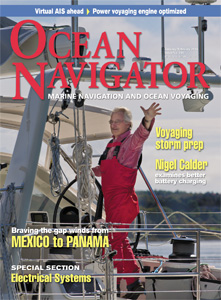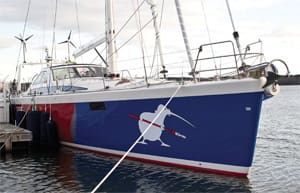Circumnavigator and regular contributor Harry Hungate recently interviewed Dr. Stanley Paris in Jacksonville, Fla., about his aborted effort to better Dodge Morgan’s record for solo non-stop world circumnavigation. According to Hungate, Paris — in his 77th year — is fitter, both mentally and physically, and more active than most men 20 years his junior.
Ocean Navigator: Just a review of your specific goals on this quest: to better Dodge Morgan’s record of 150 days, to be the oldest non-stop solo world circumnavigator, and to accomplish this without the use of fossil fuels. What drives you to seek these goals?
Stanley Paris: I have always enjoyed adventure and challenge. And, I am an endurance athlete. Years ago I drove a car from London to India and back. I swam the English Channel, I have participated in the Iron Butt — riding my motorcycle across America in less than 50 hours — several times, did Iron Man Triathlons on Hawaii, sailed around the world, and have had several successful business ventures. I’m also doing a fund-raising drive for the Foundation for Physical Therapy, which has received generous support from private individuals and corporations.
ON: Your planned route was from St. Augustine to over the top of Bermuda, then south around the Southern Ocean and return. Approximately how many nautical miles is that?
SP: The World Sailing Speed Record Council (the organization that recognizes such challenges) requires the journey to cover at least 27,000 nautical miles. You cannot just depart New Zealand, sail around Antarctica and back to New Zealand and set the record.
ON: When you decided to abort your first attempt, was there a single event or an accumulation of events that drove your decision to stop in Cape Town, South Africa?
SP: It was really the advice, or I should say insistence, of the boat designers, quickly reinforced by the builders, that due to gear failures, specifically failure of certain fittings on the rig, that I should put in for repairs. And, as these failures had occurred before I arrived in the area of strong winds, I reluctantly agreed.
ON: You suffered an injury while sail-handling on deck. How did you handle the injury? Are you fully recovered?
SP: As the winds had been light since the start, I had been flying a large headsail, good for 15 knots. The winds finally started to pick up so I began taking in the sail, but the hoop on the dousing sock snapped into two pieces and I had serious difficulty in getting the sail down. As the wind increased, the sail blew out, pieces streaming everywhere, and as I pulled the pieces down, one came down unexpectedly easily, I lost my footing and fell against a dorade guard. I fractured two ribs, could not use one arm for five days. I am a physical therapist, so I knew my injuries and how to care for them. I am fully recovered and as witness to that fact, I will be swimming the English Channel again as part of a relay team.
ON: When you arrived in South Africa, you announced that you would not make a second attempt — what changed your mind?
SP: (Broad smile) Well, I said that to take some of the worry away from my dear wife. About a week later she said to me that she knew that I wanted to go again, so why not just get on with it.
 |
|
Paris on the cover of ON as he departed for his quest. |
ON: Any changes to your personal preparation — both physical and mental?
SP: I have always kept myself in excellent physical condition. However, I underestimated the need for an exercise program aboard. Upper body strength is adequately maintained by the constant holding on, sail handling, etc., but the lower body and back weaken from lack of proper exercise. I now have a formal program with onboard exercises, which I will rigorously maintain. I swim regularly and have an exercise regimen here ashore. I have also formalized my daily inspection routine of Kiwi Spirit, which will allow me to better spot problems.
ON: And changes to Kiwi Spirit — rig, sails, electronics, hull, equipment?
SP: Kiwi Spirit is at Lyman Morse Boat Builders in Thomaston, Maine, being refitted for the coming voyage. I haven’t changed the cutter rig, but I have a new main sail. The existing one now has more than 26,000 miles on it and probably would be all right, but probably isn’t good enough. I had a problem with the battens coming loose, also. I lost two battens. My new main sail has battens in sleeves, which will prevent the battens from tearing through the sail if they are broken. The battens are fastened to the batten cars and are removed at the mast, rather than being tied in at the leech of the sail. A set of spare battens is stored in the boom. I have a new light air headsail to replace the one that I blew out, and the hoop on the dousing sock is a much better and stronger design. Deck fittings, which were a problem, have now been replaced, as have the stanchions, which are now much stronger. I have new Brooks and Gatehouse electronics — touch-screen displays for easier use when wearing gloves and to provide me with a better “velocity made good” toward my waypoints, etc.
ON: You ran short of electrical energy on your first voyage. Will you make any changes to your renewable energy resources — wind, solar, hydro?
SP: I ran short of power only because of light winds. Basically, if I have sufficient wind to beat Dodge’s record, I will have the boat speed required to drive the wind and hydro generators. I have added some extra solar panels. These are essentially reserve units in case I get struck by lightning. They are not wired up and won’t be until such time as I need them. I have several extra blades (propellers) for my four hydro generators, should I hit something and damage the blades.
ON: You have a charitable fund-raising program associated with your voyage?
SP: Yes, all donations received go fully and directly to the Foundation for Physical Therapy. I pay for donor names applied to the topsides of Kiwi Spirit.
ON: You have a website, onboard cameras and a tracking service?
SP: Yes, www.stanleyparis.com and Yellowbrick. I send four “pings” every 24 hours to Yellowbrick, which plots my track and displays course, velocity, wind speed. I’m in frequent radio contact with my support team.
ON: Your planned departure date from St. Augustine is?
SP: I am now set to depart on Nov. 8, 2014. My weather router, Commander’s, will advise on this, however.
ON: Dr. Paris, what is the most important thing you’ve learned so far in this adventure?
SP: Well, that’s hard to say, as I have learned so many things. It’s certainly been and still is a learning experience. But, I should go back to my high school days when we were addressed by the then Governor General of New Zealand, Sir Bernard Freyberg. He was brilliantly successful in his life, but his message was about failure — specifically, overcoming the fear of failure. Sir Bernard talked not about his achievements, but described several of his failures, and he ended by telling us that if we could get beyond the fear of failure, then success would come that much easier, or words to that effect. When I look back over the last several months I see my first attempt to solo circumnavigate the world not as a failure, but as a learning experience. I gain strength from that, and his advice is strong even to this day. Today’s youth are so steeped in the drive for success that many are held back by the fear of failure. Get on with it, fear not, and move ahead.
Contributing editor Harry Hungate circumnavigated with his wife, Jane Lothrop, aboard their Corbin 39 cutter, Cormorant.

